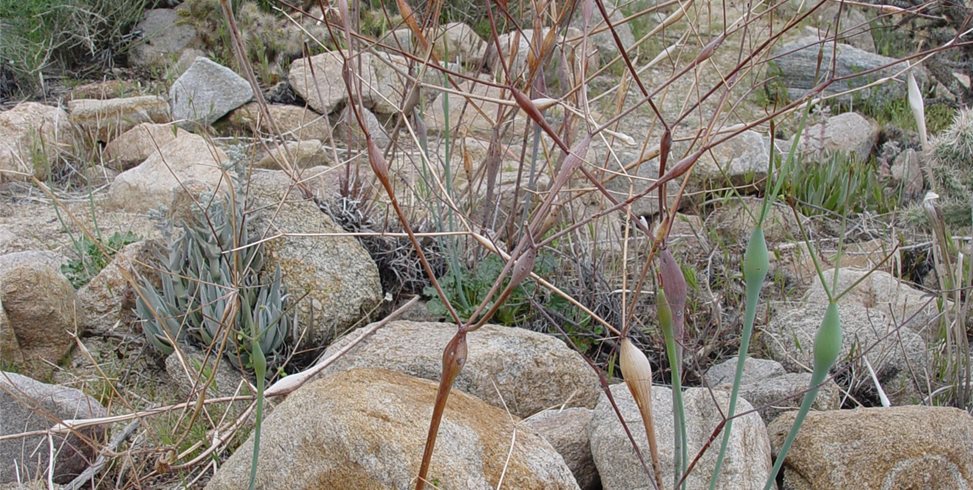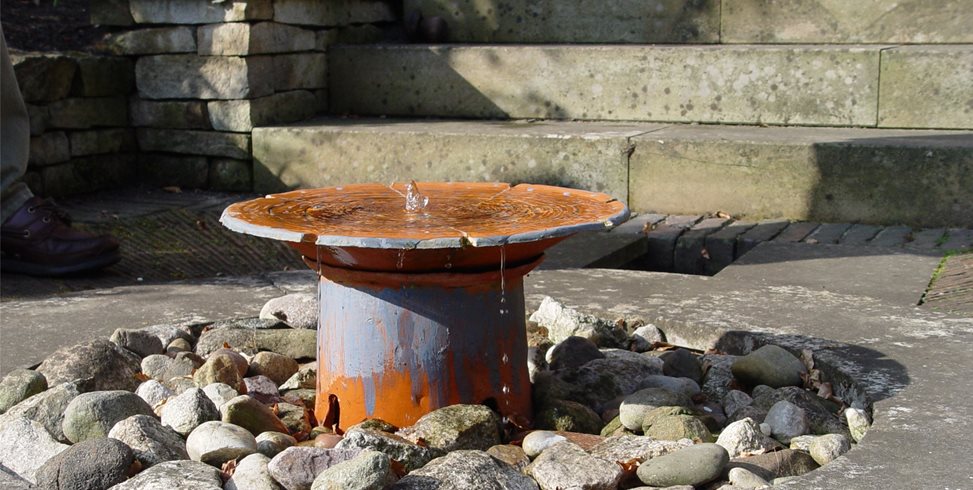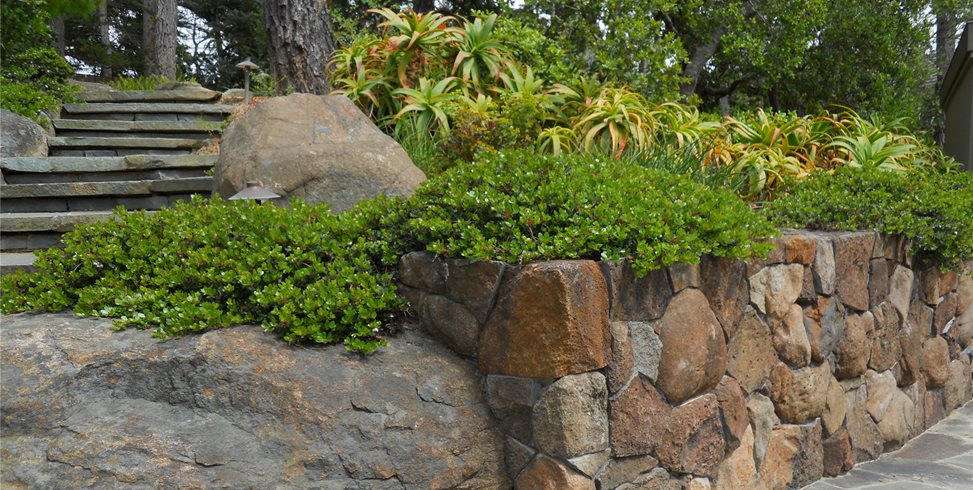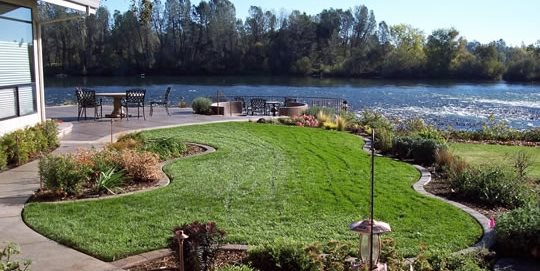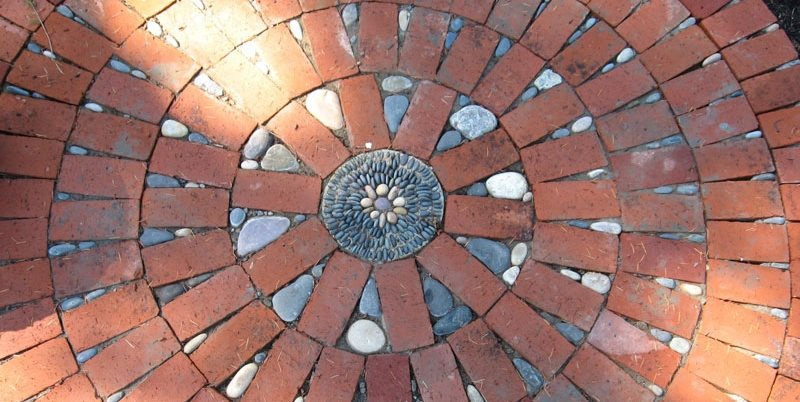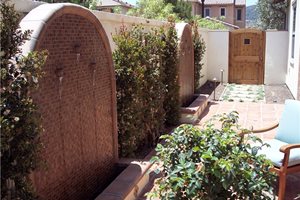Landscaping Rocky Ground
5 problems caused by rocky soil and cost saving solutionsThere are a dozen ways that rocks become incorporated into soil from the remains of glacial moraines to gravel dry washes in the Southwest. The size, density and nature of the rocks dictate whether or not they present a problem for your new landscape. While rocks will not prevent you from landscaping, they can have a big impact on the construction costs. Going into the project without a game plan for solving rock related problems can result in serious overruns.
New Englanders faced with rocky ground since colonial times called their land "rock farms". This is because rocks deeper in the soil can work their way to the surface. This illustrates why solutions to rocky ground may require an initial solution, plus long term attention to the next crop of rocks that appear. Therefore, it's important to consider rock management an ongoing task, not just something you do once during the construction of the project.
Above all, hire only landscaping professionals familiar with working in your local rocky soils. These companies have been forced to contend with these challenges and are rich in skills to overcome the many problems that result. The local designer won't propose anything too challenging for the soil type. The contractor will be ready with the right kind of heavy equipment to get the job done.
Dealing with Hidden Costs
Your designer and contractor strive to create a project that can be bid accurately, but there are often unanticipated challenges such as large underground boulders interfering with excavation. When they must apply extra services such as more labor, heavy equipment, subcontractors or unexpected hauling charges to the project, it costs them more to complete the work. You will be charged for extra services at the end of the job, so be sure to insist on pre-approving any and all "extra services" before implementing them to ensure the current solution fits within your budget.
Problem #1: Creating lawn
Turf grass requires a rock free surface, not just to help the grass grow but to make it possible to mow closely. Landscapers have learned to grade the proposed lawn area first then manage the visible rocks. Golf course contractors use rock rakes and other specialized types of heavy equipment to comb rocks from the surface of large areas of soil. Once the area is relatively rock free, the final solution is to import topsoil to lay over the cleaned ground so the surface can be graded to perfection. This layer also reduces the potential for rocks to rise in the future since the topsoil may be denser than the native ground beneath.
Problem #2: Grading
Grading rocky ground to ensure the surface drains properly or supports a specific structure requires a great deal of land form alteration. In mountain towns or areas where rocky soils are common, grading may not be as easily achieved because rock can literally tear up the blades of a Bobcat or a grading tractor. This is doubly difficult when the rock is in very dense clay soil that is reluctant to give under pressure.
If your contractor's equipment is not up to the task, or if it's damaged, repairs not only delay completion of the project, cost of parts and labor may be passed on to you. Grading soils with a wide range of rock sizes is the most challenging because you must size the heavy equipment to meet the challenge of the largest, heaviest stones. If your contractor must rent a large dozer, or subcontract to a grading contractor, that cost may prove considerable. The solution to grading rough ground is to hire an engineering contractor well experienced in working this kind of earth.
Problem #3: Excavation
Building a landscape requires excavation - be it a planting hole, a swimming pool, an arbor footing, fence post holes or any kind of foundation. When you solicit bids, it's important to understand that soil conditions can make it impossible to use certain types of equipment essential to the landscaper's trade. For example, if you hire an irrigation contractor who typically uses a trenching machine for burial of long runs of pipe, that machine may not function properly or it can be damaged in rocky soil. If he is not aware of rocky soil conditions on site, he will estimate the job based on mechanized trenching. If he finds the trencher won't work in that soil, he must hand dig the trenches. The bill for extra labor and time delays ultimately comes to you. Even something as simple as a board fence becomes problematic in rocky soil when digging the post holes by hand is next to impossible. The best solution to this is to employ a mechanized auger to drill the holes for fence posts, trees and footings.
- Pro Tip: When large chunks of rock exist where vital foundations or utilities must be located, the challenge of removing them may require a jack hammer, blasting or very heavy equipment to relocate the boulder. Allow for this contingency so you won't be surprised if large boulders do show up in excavations.
Problem #4: Stockpile & Removal
Inevitably rocky ground will produce a huge crop of rock by the time your project is completed. Moving excess stones off site means additional costs must be calculated for gathering and loading the rock onto a dump truck. You may even have to pay to dump the rock somewhere else.
The best solution is to plan for excess rock by designing it into the project itself. This requires the designer to be well aware of the nature of the stone on site. She will be able to create elements that call for similar size rock, turning this liability into a benefit. The size and shape of the rock dictates how it can be used because slates or flagstone provide more opportunities than cobbles. Rock is useful for many on site applications such as:
- Rip rap drainage ways to slow water velocity (line the ditch).
- Line small slopes to reduce erosion.
- Use to fill in an underground French drain or sump.
- Stack into a dry stone wall or short curb.
- Integrate into masonry for more natural mow strips and walkway edging.
Problem #5: Planting
Every plant on your site will require a planting hole. Rocky ground requires the planting crew utilize special tools such as a heavy pry bar and pick-axe for larger tree holes. For larger projects the use of a mechanized auger for tree and shrub planting holes can save time and money.
Big problems crop up with boxed specimen trees with a large rootball, and lesser holes for five and fifteen gallon shrubs and trees. These require proportionately sized holes where your contractor may encounter large rocks, even boulders deeper down that cannot be easily removed. One solution is to shift the location of the plant one way or another to avoid the rock. Another option is to use a jack hammer to break it up prior to removal. Either way, this takes more time and if your contractor has not budgeted accordingly, you'll be met with a request for extra services.
While these soils contain their own problems, the rocks they yield are a valuable free on site resource for creating one-of-a-kind design elements. This green approach to rock management is nothing new; for the rock cottages of Ireland and dry stone walls of colonial New England are part of the regional design vernacular. So long as you plan ahead, rocks become a huge benefit. Nothing else can give your home landscape this age old beauty.

 Backyards
Backyards
 Front Yards
Front Yards
